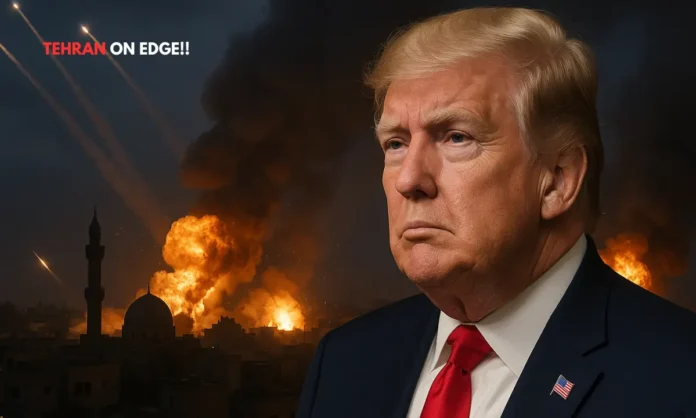Summary
- President Trump urged immediate civilian evacuation of Tehran amid fears of Israeli nuclear retaliation.
- Iran and Israel exchanged missile strikes for a fifth consecutive day, with over 250 total civilian casualties reported.
- Ceasefire efforts by Gulf intermediaries stalled as Tehran offered nuclear concessions in exchange for de-escalation.
Middle East on Edge: Nuclear Tensions and the Evacuation Trigger
As the Iran-Israel conflict entered its fifth day, global attention turned sharply to Washington—specifically to a single social media post from former U.S. President Donald Trump. “Everyone should immediately evacuate Tehran!” he wrote on Truth Social. The warning followed renewed missile exchanges between Israel and Iran, with airstrikes in Tel Aviv and retaliatory explosions in central Tehran and the sensitive Natanz nuclear facility.
The urgency of Trump’s message was compounded by the White House’s abrupt announcement that he would leave the G7 summit in Canada early to convene his National Security Council. Behind the scenes, sources revealed that Iran had asked Gulf mediators—Qatar, Oman, and Saudi Arabia—to press Trump into restraining Israeli Prime Minister Benjamin Netanyahu. In exchange, Tehran signaled openness to renewed nuclear concessions.
The warning sent crude oil prices surging by over 2%, underscoring just how quickly a regional war was morphing into a global economic and security crisis.
🚨🇺🇸 SITUATION ROOM WAR ALERT: MASS EVACUATION OF TEHRAN AFTER TRUMP’S ORDER — WHITE HOUSE ON FULL MILITARY STANDBY
— Medeea Greere (@GreereMedeea) June 17, 2025
BREAKING: Mass evacuation in Tehran explodes after President Trump issues direct Truth Social order. Israeli airstrikes dismantle Iran’s defense grid. White House… pic.twitter.com/37yN64bYoj
Tehran and Tel Aviv: Cities Under Siege, Diplomacy in Shambles
- Iranian death toll reaches 224, while Israel reports 24 civilian deaths and nearly 3,000 evacuations.
- Israeli missiles reportedly cripple Iran’s Natanz nuclear facility, destroying up to 15,000 centrifuges.
- Iran retaliates with strikes on Tel Aviv, prompting air raid sirens and midnight evacuations.
- Gulf intermediaries attempt backchannel diplomacy; nuclear negotiations with Oman suspended.
- Trump refuses to sign G7 ceasefire appeal, insists Iran must accept “strict curbs.”
The scope of destruction in both Tehran and Tel Aviv is unprecedented. Iranian officials confirmed major damage to the Natanz enrichment site and reported chaos in Tehran’s streets as explosions echoed across the capital. Meanwhile, in Tel Aviv, Israel’s Iron Dome struggled to intercept Iranian ballistic missiles, triggering late-night sirens and population displacement.
Despite this, the nuclear backchannel—hosted by Oman—was abruptly cancelled, a casualty of ongoing violence. Iran’s Foreign Minister Abbas Araqchi stressed that no negotiation could continue “under aerial bombardment.” Nevertheless, regional sources suggest Iran may resume talks if Israel pauses its airstrikes, even offering flexibility on uranium enrichment limits.
In response, Israel doubled down. Netanyahu, addressing reporters in Canada, reaffirmed the 60-day ultimatum he claims was given to Tehran. “We gave diplomacy a chance,” he said. “Now we will finish what we must.”
“Evacuate Tehran”: Trump’s Unfiltered Diplomacy Reshapes the Battlefield
- Trump issues dramatic call for Tehran evacuation, citing Iran’s failure to sign a nuclear deal.
- Evacuation post spooks markets; oil surges 2% as fears of escalation mount.
- Trump confirms early exit from G7 to deal with crisis, refuses to endorse joint de-escalation statement.
- Macron welcomes exit, calls Trump’s intervention “timely for peace efforts.”
- Trump warns: “Iran is foolish not to sign. A deal will be signed—or something else will happen.”
Trump’s messaging has created shockwaves—both diplomatically and psychologically. While critics decry the call for Tehran’s evacuation as needlessly provocative, allies note it has turned global attention squarely toward nuclear de-escalation.
European leaders are split. Macron sees Trump’s early G7 exit as “an opportunity to unlock movement,” while Germany and Japan urge restraint. The United Nations Security Council has scheduled an emergency session.
Meanwhile, Israeli operations expanded on Day 5. They targeted Iran’s state broadcaster and broadcast towers, including a live studio during a news bulletin. International Atomic Energy Agency (IAEA) head Rafael Grossi confirmed that Israel’s strike on Natanz likely disabled over 15,000 centrifuges. Yet Fordow, another Iranian facility, remained largely untouched.
Fallout and Future Lines: What Happens If the Deal Fails?
- Pakistan denies Iran’s claim of nuclear support but backs Tehran politically.
- China urges citizens to evacuate Israel; Israeli airspace remains closed.
- Netanyahu warns of continued air dominance, while Iran hints at deeper retaliation.
- Diplomacy now hinges on a fragile Gulf corridor—if hostilities pause long enough.
- Global markets brace for shocks as energy corridors remain under threat.
With Trump refusing to endorse the G7’s draft ceasefire appeal and Netanyahu committed to military escalation, the potential for a negotiated end looks dim. Iran, for its part, appears open to compromise—if airstrikes cease. Yet trust is virtually non-existent.
Adding to the uncertainty is the role of regional players. Pakistan’s ambiguous position—denying nuclear threats but vocally supporting Iran—raises alarm about wider Muslim world polarization. China, increasingly concerned, urged its citizens to leave Israel by land amid closure of Israeli airspace.
The Iran-Israel war has never been more direct. What began as covert sabotage has turned into the most open and violent confrontation between the two nations in modern history. And with each day, the stakes move further from the battlefield and closer to diplomacy—or disaster.
The Last Move: Ceasefire or Chain Reaction?
At this stage, every missile launched carries more than explosive risk—it threatens to destroy decades of fragile, often secret, diplomatic architecture. Trump’s blunt ultimatum and Netanyahu’s calculated offensives have together created a moment of reckoning.
The world watches as Tehran’s skies burn and Tel Aviv reels. Whether a ceasefire can be achieved now rests not only on battlefield restraint but on the revival of credibility—of leaders, treaties, and truth. With nuclear facilities damaged, regional powers repositioning, and markets trembling, this war may be entering its most dangerous phase.
And still, as one diplomat put it: “The next strike may not just be military. It may be a point of no return.”


